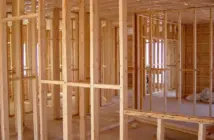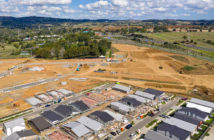Despite continuing growth in construction costs, data from the Building Research Association of New Zealand (BRANZ) indicates falling section prices are one of the reasons new builds are now more affordable

Unsplash – Ted Balmer
The high cost of building continues to make new builds inaccessible for many, though it is becoming more affordable, with section prices down 15% ($35,000) from their mid-2022 peak.
The latest quarterly data (January–March 2025) from BRANZ Build Insights reveals that the average price for a section and new standalone house is down 4.1% to $1,018,000 – $43,000 less than the previous quarter (October–December 2024).
However, this remains substantially more expensive (+$201,000) than buying an existing home.
A driving factor for this is that house build prices have continued to increase in recent years and at nearly twice the rate of inflation. Latest estimates show that building a basic 200m2 home, which would have cost just over $650,000 in mid- 2022, will now cost $777,000. This is nearly a 20% increase over a time when general inflation rose 12%. Existing property prices have increased slightly over the same period.
“We’re still experiencing high build costs since the pandemic, from a number of factors, including increased material costs, higher wage costs as well as the general inflation we’re seeing across all sectors,” BRANZ Senior Economist Matt Curtis says.
“But this new data is showing us the first signs of improving affordability in the new-build sector and since 2023, the number of building consents issued for standalone homes has been slowly increasing – growing 5% in the year ending March 2025 compared to the year ending March 2024.
“We’re also seeing house sizes getting smaller to adapt to rising costs. The average size of new standalone houses consented in 2024 was 176m2 compared to 184m2 in 2023,” he says.
“Generally, smaller and simpler houses are a good thing – they cost less to build and are also more cost-effective for people to live in, with less energy and maintenance expenses.”
Since 2022, the building and construction industry has faced significant challenges, including a decline in new startups and notable increases in business liquidations (up 37% in the year to February 2025 compared to a year earlier).
However, the sector’s skills pipeline shows a more promising outlook. This has been underscored by a surge in trades training, and carpentry apprenticeships have more than doubled in the past decade, with 21,165 apprentices in 2023 compared to 9,280 in 2014.
Q1 2025 building and construction sector insights:
- Reduced section prices: The average 500m2 section in the March quarter is $240,000, $35,000 less than in mid-2022. There are however significant regional variations: For instance, the average cost of a 500m² section in Auckland is over $505,000, compared to $65,000 in the West Coast.
- Reduced overall new build cost: The total average price for a section and new build standalone house is $1,018,000 – $42,000 less than the $1,060,000 in December 2024.
- Construction costs outstrip inflation: The cost to build a house has increased by nearly 20% since mid-2022, with an average 200sqm house now costing $777,000. Over the same period when general inflation rose 12%.
- Shift in consents: Building consents for standalone houses have increased slightly, whereas consents for attached dwellings have decreased by 17%.
- Decline in consent value: The total value of residential building consents has fallen by 13% compared to 2023 after adjusting for inflation.
- Growth in construction businesses: There are more construction businesses and workers now than ever before, with 81,891 businesses operating in 2024.
- Increase in construction businesses: There are now more construction businesses than ever before – 81,891 in 2024, outpacing the growth rate of all industries in the last decade. However, construction business liquidations were up 37%, and made up 31% of all business liquidations.
- Positive long-term outlook: Despite the economic downturn, the long-term outlook remains positive, with more construction businesses being started and fewer ceasing operations compared to other industries.
- Surge in apprenticeships: Carpentry apprentices have more than doubled in the past decade, with 21,165 apprentices in 2023 compared to 9,280 in 2014.
- Increase in trades training: Participation in trades training has nearly doubled since 2014, with the total number of trainees, apprentices, and tertiary qualification students in construction increasing from 57,000 to 93,000 in 2023.
Click here for the BRANZ Build Insights Tool
Click here to view the full BRANZ Build Insights Q1 Economic Report



